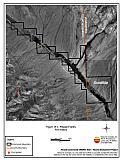14.0 Pleasant Valley
14.1 Risk and Hazard Assessment
Pleasant Valley is located in northeastern White Pine County along the Nevada/Utah border south of Goshute (see Figure 14-1). The risk and hazard assessment results given below pertain to the Nevada portion of the community. The hazard assessment resulted in classifying Pleasant Valley in the Moderate Hazard Category (52 points). A summary of factors that contributed to the hazard rating is included in Table 14-2. Primary factors that determined the hazard rating for Pleasant Valley were the lack of a local fire department and limited water drafting sources for fire suppression apparatuses.
14.1.1 Community Design
Pleasant Valley is a combination of trailer homes in a classic interface cluster in the south end of the valley and several ranches located throughout the valley. Most of the trailer homes are recreational vehicles that are occupied seasonally. Ten homes were observed during the assessment: five on lots of one acre or less and five on lots of one to ten acres.
- Access: There are no major highways near Pleasant Valley. Pleasant Valley Road (White Pine County Road 35), the only road through the community, intersects with other County roads. Community roads are of adequate width and grade for fire suppression equipment maneuverability and two-way vehicle passage.
- Signage: No street signs or addresses were observed in Pleasant Valley. Clear and visible residential addresses and street signs are important to aid firefighting personnel in locating homes during low visibility conditions that occur during a wildland fire.
- Utilities: Utilities are all above ground including power lines and propane tanks. In some cases the minimum of ten feet of vegetation clearance was not present around propane tanks.
14.1.2 Construction Materials
All of the homes observed in Pleasant Valley had non-combustible or highly fire resistant siding such as medium density fiberboard and non-combustible roofing materials such as tile, metal, or composition. None of the homes has unenclosed porches, decks, or balconies where sparks and embers can be trapped, smolder, ignite, and eventually spreading fire to the home.
14.1.3 Defensible Space
All of the homes surveyed in Pleasant Valley had landscaping that meets the minimum defensible space requirement to help protect the home from damage or loss during a wildfire.
14.1.4 Suppression Capabilities
Pleasant Valley has no local fire suppression resources. Resources are available from the BLM Ely Field Office and the NDF White Pine County Fire Protection District as described in Section 4.1.1.
Water Sources and Infrastructure
The only water sources for fire protection in Pleasant Valley are ranch ponds and wells.
14.1.5 Factors That Affect Fire Behavior
The terrain within the Pleasant Valley community varies from flat to nearly twenty percent slopes. Predominant winds are from the west to southwest, although summer thunderstorms can cause erratic winds. Agricultural fields provide a buffer zone between residences and wildland fuels throughout the community. Fuels beyond the agricultural lands are primarily dominated by black sagebrush and rabbitbrush with a cheatgrass component. Fuel loads in this area were estimated at less than one ton per. Vegetation around the cluster of trailer homes in the southern portion of Pleasant Valley consists of big sagebrush, rabbitbrush, and greasewood. The fuel load in this area was estimated at three to four tons per acre. Vegetation along Pleasant Valley Draw consists of Russian olive, willows, Wood’s rose, rabbitbrush, and an understory of perennial grasses. Fuel loading in this area is estimated at one to three tons per acre. Fuel hazards in the community were considered moderate, with some isolated occurrences of high hazard fuels southwest and northeast of the community.
14.1.6 Worst Case Wildfire Scenario
The worst-case fire scenario for Pleasant Valley would likely occur during a dry lightning storm with multiple fire ignitions west, north, or south of the community. Erratic, downslope winds could cause the wildfire to spread rapidly through the understory vegetation. Most structures in Pleasant Valley are not at risk of damage from a wildfire due to irrigated agricultural buffer zones; however, some ranch outbuildings, improvements, and stockpiled commodities that are stored near wildland fuels could be damaged or destroyed in the event of a wildfire. Embers flying into stockpiled hay bales could ignite the haystacks or smoke from nearby fires could damage the hay making it mostly unpalatable for livestock.
14.1.7 Ignition Risk Assessment
Pleasant Valley has a high risk of ignition based on fuel loading and past wildfire history. The primary ignition risk in Pleasant Valley is lightning, although human caused ignitions can happen at any time.
14.2 Risk and Hazard Reduction Recommendations
Despite the reduced risk of damage or loss to structural properties, residences in Pleasant Valley exhibit unique conditions because of their remote location and distance from any fire suppression resources. Hay and alfalfa fields, stockpiled bales, livestock, ranching and farming equipment, and fuel tanks are assets that require special protection because of their considerable value to ranchers and farmers. Not only can stockpiled hay combust or ignite easily, but smoke can make the hay unpalatable and unusable for livestock feed.
14.2.1 Defensible Space Treatments
Defensible space treatments are an essential first line of defense for residential structures. Significantly reducing or removing vegetation within a prescribed distance from structures (30 feet to 200 feet depending upon slope and vegetative fuel type) reduces fire intensity and improves firefighter and homeowner chances for successfully defending a structure against an oncoming wildfire.
Property Owners Recommendations
- Remove, reduce, and replace vegetation around homes according to guidelines provided in Appendix E. This area should be kept:
- Lean: There are only small amounts of flammable vegetation.
- Clean: There is no accumulation of dead vegetation or other flammable debris.
- Green: Existing plants are healthy and green during the fire season.
- Continue to maintain defensible space annually.
- Install spark arrestors on chimneys.
- Maintain a space clear of accumulated vegetation and combustible materials for at least ten feet around propane and fuel tanks.
- Create a firebreak of bare ground or gravel for 100 feet around stockpiled commodities. Because it is dried plant material, stacked or baled hay is vulnerable to ignitions from internal combustion or from outside sources.
- Plant a seed mixture of fire-resistant species around residential structures and ranch outbuildings.
- Purchase a backup power system for properties on individual wells in the case of loss of commercial power during a large wildland fire.
- Remove or board up any abandoned trailers or other structures to prevent flying embers from entering and igniting these structures.
14.2.2 Fire Suppression Resources
Adequate training, equipment, and water drafting supplies are critical to all firefighters, whether they are first responders, volunteer fire department personnel, or agency personnel. These matters are also of special importance to all communities, especially those located in remote portions of the county. The following recommendations are related to actions the county and fire departments can take to increase the quality of fire suppression response in their community.
White Pine County
- Purchase and station a pick-up truck and a one-piece, slip-on, 100 to 200-gallon tank and pump unit with hose and hose reel in Pleasant Valley during the fire season. This equipment, fitted properly for the size and weight limitations of the truck, can be used to provide initial attack of small ignitions.
- Identify agricultural wells that can be used for filling water tenders and engines, and install a water storage tank with at least 10,000 to 15,000-gallon capacity for fire protection. Agricultural wells require fittings with fire department threads for filling water tenders and engines.
Property Owner, Nevada Division of Forestry, and White Pine County
- Coordinate with the Nevada Division of Forestry to organize a volunteer fire department in Pleasant Valley. Provide new VFD members with wildland and State Fire Marshal structure firefighting training for initial attack of ignitions both within and near the community.
14.2.3 Community Coordination
Many of the most effective activities aimed at reducing the threat of wildfire for the Pleasant Valley community require that individual property owners coordinate with each other and with local fire authorities. Defensible space, for example, is more effective in small communities when applied uniformly throughout entire neighborhoods. Public education and awareness, neighbors helping neighbors, and proactive individuals setting examples for others to follow are just a few of the approaches that will be necessary to meet the fire safe goals in the community.
Nevada Division of Forestry
- Distribute copies of the current “Living With Fire” publication. This publication is available free of charge from the University of Nevada Cooperative Extension.
- Request the University of Nevada Cooperative Extension to develop a “Living With Fire” type publication tailored to the concerns of rural Nevada ranchers. The publication should include solutions for power back up, foaming systems, fire resistant seeding, and ranch site layout suggestions.
| Involved Party | Recommended Treatment | Recommendation Description |
|---|---|---|
| Property Owners | Defensible Space Treatments | Remove, reduce, and replace vegetation around homes, stockpiled hay, and equipment storage areas according to the guidelines in Appendix E. Maintain defensible space as needed to keep the space lean, clean, and green. |
| Fire Suppression Resources | Coordinate with the County and NDF to organize a volunteer fire department. | |
| University of Nevada Cooperative Extension | Community Coordination | Develop a “Living With Fire” publication for rural ranch communities. |
| Nevada Division of Forestry | Community Coordination | Distribute copies of the publication “Living With Fire.” |
| Fire Suppression Resources | Coordinate with residents and the County to organize a volunteer fire department in Pleasant Valley. Coordinate with residents and NDF to organize a volunteer fire department in Pleasant Valley. Provide annual wildland firefighter training to VFD members. |
|
| White Pine County | Fire Suppression Resources | Develop water storage for fire protection. Purchase and station a pick-up truck and a one-piece, slip-on, 100 to 200-gallon tank and pump unit with hose and hose reel in Pleasant Valley during the fire season. |
Table 14-2Pleasant Valley Wildfire Hazard Rating Summary |
 |
Figure 14-1Pleasant Valley Fire History |
 |
